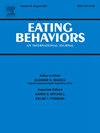Eating behavior profiles in children following a 10-week lifestyle camp due to overweight/obesity and low quality of life: A latent profile analysis on eating behavior
IF 2.4
3区 医学
Q2 PSYCHIATRY
引用次数: 0
Abstract
Lifestyle interventions are the preferred treatment option for childhood obesity, but the effectiveness varies among individuals, and not all children benefit from treatment which may be explained by different eating behavior profiles. This study aimed to identify eating behavior latent profiles in 7–14 year olds with overweight/obesity and low quality of life (QoL) referred to a 10-week multicomponent lifestyle camp, characterize the profiles, and explore treatment effect across profiles. In total, 174 children with overweight/obesity were included. At baseline, 10 and 52-weeks, participants answered questionnaires on eating behavior traits, QoL, and overeating (OE)/loss-of-control (LOC) eating, while anthropometry was measured. Latent profile analysis was performed to identify eating behavior profiles upon entering. A three-profile solution was identified: Low Food Approach (LFA) showing a low degree of Food Responsiveness (FR) and Emotional Overeating (EOE), Medium Food Approach (MFA) characterized with a moderate FR and EOE, and High Food Approach (HFA) showing the highest degree of FR and EOE. The HFA profile (42 %) was younger, had lowest QoL, and highest body mass index standard deviation score (BMI-SDS) compared to the remaining profiles. The HFA profile showed superior improvements in QoL and OE after 10-weeks, despite no differences in BMI-SDS changes between the profiles. Additionally, the HFA profile showed greater improvements in QoL after 52-weeks but continued to have the highest BMI-SDS. This study emphasizes the importance of personalized approaches in childhood obesity treatment, and identifying eating behavior profiles may be a simple tool for tailoring future intervention strategies.
超重/肥胖和低生活质量儿童在10周生活方式训练营后的饮食行为概况:对饮食行为的潜在概况分析
生活方式干预是儿童肥胖的首选治疗方案,但效果因人而异,并不是所有儿童都能从治疗中受益,这可能是由不同的饮食行为特征来解释的。本研究旨在通过为期10周的多组分生活方式训练营,确定7-14岁超重/肥胖和低生活质量(QoL)儿童的饮食行为潜在特征,对这些特征进行表征,并探讨不同特征的治疗效果。总共包括174名超重/肥胖儿童。在基线,10周和52周,参与者回答了关于饮食行为特征,生活质量和暴饮暴食(OE)/失去控制(LOC)饮食的问卷,同时测量了人体测量。进行潜在特征分析以确定进入时的饮食行为特征。确定了三种解决方案:低食物方法(LFA)表现出低程度的食物反应(FR)和情绪性暴饮暴食(EOE),中等食物方法(MFA)表现出中等程度的FR和EOE,高食物方法(HFA)表现出最高程度的FR和EOE。与其他类型的患者相比,HFA组(42%)更年轻,生活质量最低,体重指数标准偏差评分(BMI-SDS)最高。10周后,尽管两组的BMI-SDS变化无差异,但HFA组的QoL和OE均有显著改善。此外,52周后,HFA谱显示生活质量有较大改善,但BMI-SDS仍然最高。这项研究强调了个性化方法在儿童肥胖治疗中的重要性,确定饮食行为概况可能是定制未来干预策略的简单工具。
本文章由计算机程序翻译,如有差异,请以英文原文为准。
求助全文
约1分钟内获得全文
求助全文
来源期刊

Eating behaviors
Multiple-
CiteScore
4.20
自引率
3.60%
发文量
65
审稿时长
60 days
期刊介绍:
Eating Behaviors is an international peer-reviewed scientific journal publishing human research on the etiology, prevention, and treatment of obesity, binge eating, and eating disorders in adults and children. Studies related to the promotion of healthy eating patterns to treat or prevent medical conditions (e.g., hypertension, diabetes mellitus, cancer) are also acceptable. Two types of manuscripts are encouraged: (1) Descriptive studies establishing functional relationships between eating behaviors and social, cognitive, environmental, attitudinal, emotional or biochemical factors; (2) Clinical outcome research evaluating the efficacy of prevention or treatment protocols.
 求助内容:
求助内容: 应助结果提醒方式:
应助结果提醒方式:


